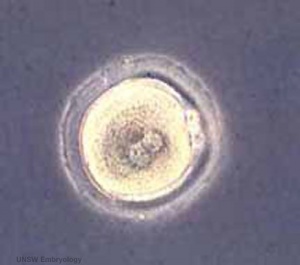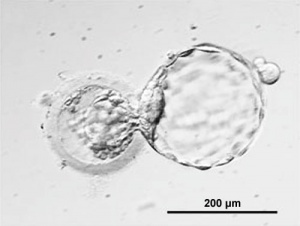2009 Lecture 3: Difference between revisions
| Line 64: | Line 64: | ||
** zona pellucida is lost too early, allows premature tubal implantation | ** zona pellucida is lost too early, allows premature tubal implantation | ||
* embryo may develop through early stages, can erode through the uterine horn and reattach within the peritoneal cavity | * embryo may develop through early stages, can erode through the uterine horn and reattach within the peritoneal cavity | ||
== Uterus == | |||
Endometrium | |||
3 layers in secretory phase of menstrual cycle | |||
compact | |||
spongy | |||
basal | |||
Myometrium | |||
muscular layer outside endometrium | |||
contracts in parturition | |||
Perimetrium | |||
Tunica serosa | |||
Endometrium Layers | |||
Compact | |||
implantation occurs in this layer | |||
dense stromal cells, uterine gland necks, capillaries of spiral arteries | |||
Spongy | |||
swollen stromal cells, uterine gland bodies, spiral arteries | |||
Basal | |||
not lost during menstruation or childbirth, own blood supply | |||
Uterus Cycle Changes | |||
Cycle- Ovary and Uterus | |||
Uterine Changes 1 | |||
Endometrium | |||
decidual reaction | |||
occurs initially at site of implantation | |||
deposition of glycogen | |||
spreads throughout uterus | |||
not at cervix | |||
decidual cells | |||
indicative of pregnancy | |||
curette | |||
==UNSW Embryology Links== | ==UNSW Embryology Links== | ||
Revision as of 14:25, 2 August 2009
Week 1 and 2
Introduction
Following fertilization the first week is a series of rapid cell divisions, still contained within the zona pellucida, and still floating and being propelled within the uterine tube towards the uterine body. At the end of the first week and within the second week the process of implantation and early differentiation of cells that will form the embryo and the placenta.
Lecture Overview
- Week 1-2 of human development
- Fertilization options - In vitro fertilization
- Zygote, Morula, Blastocyst
- Cell layers - Trophoblast, Syncytiotrophoblast, Cytotrophoblast, Embryoblast
- Implantation - Normal, Ectopic, Uterine changes, Blastocyst implantation changes
Fertilization Options
- Natural sex
- Artificial insemination of mother with father's sperm, with mother with donor sperm, with egg and sperm donors, using surrogate mother
- In vitro fertilization (IVF) using egg and sperm of parents
- Intra-Cytoplasmic Sperm Injection (ICSI), frozen embryos, pre-implantation Genetic Diagnosis (PGD), egg donor, sperm donor, egg and sperm donor, surrogate using parents' egg and sperm, surrogate and egg donor, surrogate and sperm donor, surrogate using her egg and sperm from baby's father, surrogate using egg and sperm donors
Formation of Zygote
- male and female pronuclei, 2 nuclei approach each other and nuclear membranes break down
- DNA replicates, first mitotic division
- sperm contributes centriole which organizes mitotic spindle
Cleavage of Zygote
- cleavage of zygote forms 2 blastomeres and is cleavage with no cytoplasm synthesis
- special "embryonic" cell cycle S phases and M phases alternate without any intervening G1 or G2 phases (MSMSMSMS, adult MG1SG2) therefore individual cell volume decreases
- cell division is initially synchronous, then asynchronously
- slow- centre cells, larger fast- peripheral cells
Morula
- about day 4 is a solid ball of 16-20 cells with peripheral cells flattened against zona pellucida
- compaction occurs forming a cavity and leading to the next blastocyst stage
Blastocyst
- about day 5 have 2 identifiable cell types and a fluid-filled cavity (blastoceol)
- trophoblast layer - peripheral flattened cells, forms the placenta and placental membranes
- inner cell mass - embryoblast, mass of rounder cells located on one wall of the blastocoel, forms entire embryo
Blastula Cell Communication - two forms of cellular junctions
- gap junctions, allow electrically couple cells of epithelium surrounding a fluid-filled cavity
- tight junctions, close to outer surface create a seal, isolates interior of embryo from external medium
Blastocyst Hatching - zona pellucida lost, ZP has sperm entry site, and entire ZP broken down by uterine secretions and possibly blastula secretions. Uterine Glands - secretions required for blastocyst motility and nutrition
Implantation
- commences about day 6 to 7
- Adplantation - begins with initial adhesion to the uterine epithelium
- blastocyst then slows in motility, "rolls" on surface, aligns with the inner cell mass closest to the epithelium and stops
- Implantation - migration of the blastocyst into the uterine epithelium, process complete by about day 9
Normal Implantation Sites - in uterine wall superior, posterior, lateral
Abnormal Implantation Sites - Ectopic Pregnancy
- if implantation occurs in uterine tube or outside the uterus
- sites - external surface of uterus, ovary, bowel, gastrointestinal tract, mesentry, peritoneal wall
- If not spontaneous then, embryo has to be removed surgically
Tubal pregnancy
- 94% of ectopic pregnancies
- uterine epithelium is damaged (scarring, pelvic inflammatory disease)
- zona pellucida is lost too early, allows premature tubal implantation
- embryo may develop through early stages, can erode through the uterine horn and reattach within the peritoneal cavity
Uterus
Endometrium 3 layers in secretory phase of menstrual cycle compact spongy basal Myometrium muscular layer outside endometrium contracts in parturition Perimetrium Tunica serosa Endometrium Layers Compact implantation occurs in this layer dense stromal cells, uterine gland necks, capillaries of spiral arteries Spongy swollen stromal cells, uterine gland bodies, spiral arteries Basal not lost during menstruation or childbirth, own blood supply Uterus Cycle Changes Cycle- Ovary and Uterus Uterine Changes 1 Endometrium decidual reaction occurs initially at site of implantation deposition of glycogen spreads throughout uterus not at cervix decidual cells indicative of pregnancy curette
UNSW Embryology Links
Glossary Links
A | B | C | D | E | F | G | H | I | J | K | L | M | N | O | P | Q | R | S | T | U | V | W | X | Y | Z
Next Lecture
- Dr Mark Hill 2009 UNSW CRICOS Provider Code No. 00098G

